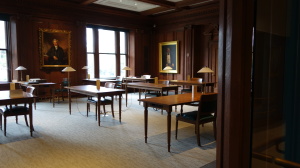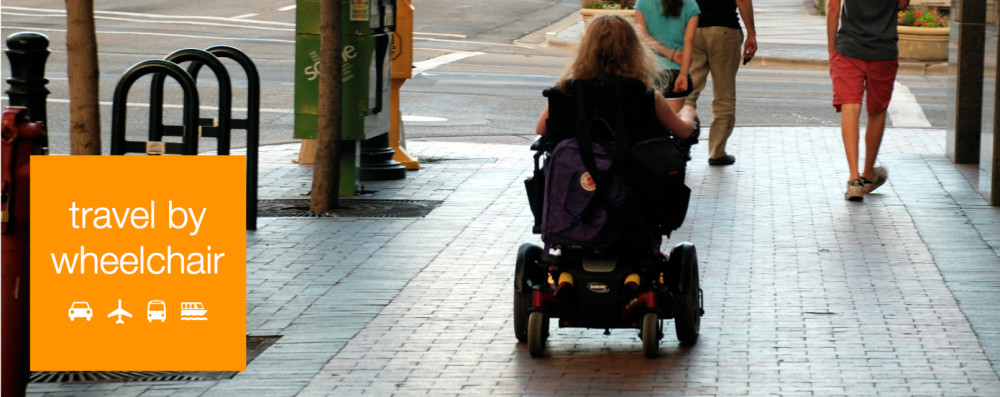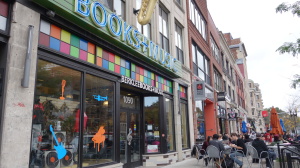John Adams and John Quincy Adams were members. So were Ralph Waldo Emerson and Henry Wadsworth Longfellow. John F. Kennedy was too.
 Members of what? The Massachusetts Historical Society, which has a scholarly, sombre reading room (in which I know that even I could pen a masterpiece) and a research room (from which David McCullough and Nathaniel Philbrick have gathered information for their literary works). The Society also offers lunch seminars (many are free and open to the public) and provides enrichment to K-12 history teachers throughout the area.
Members of what? The Massachusetts Historical Society, which has a scholarly, sombre reading room (in which I know that even I could pen a masterpiece) and a research room (from which David McCullough and Nathaniel Philbrick have gathered information for their literary works). The Society also offers lunch seminars (many are free and open to the public) and provides enrichment to K-12 history teachers throughout the area.
Recently, I attended Barbara Berenson‘s lecture on how Boston’s abolitionists (think William Lloyd Garrison, Theodore Parker, William Cooper Nell, and Frederick Douglass) fueled the flames leading to the Civil War. Berenson, a compelling Civil War historian and speaker, side-lines as a senior attorney at the Massachusetts Supreme Judicial Court. She has written both a guide to the Freedom Trails Walking Tours of Civil War Boston and a book, Boston and the Civil War: Hub of the Second Revolution. Berenson also leads walking tours – when I take one, I’ll let you know how accessible they are. In the meantime, she is more than worth listening to, if you are interested in Boston’s Civil War history.
The Historical Society is accessible by outside ramp, although you must be buzzed in to gain entrance). There is an accessible bathroom on the first floor and an elevator to the exhibits and seminar room on the second floor. The research and reading rooms on the first floor are accessible. I’d say parking is the biggest issue here, as it is on the end of Boylston Street near the Fenway (right next door to Berklee College of Music), and the parking garages are spread out. Sidewalks are plenty wide to accommodate wheelchairs and giant-musical-instrument-toting scholars; there are ample curb cuts (on most every corner of Mass Ave save one, weirdly) and pedestrian lights (although be prepared to hustle as they’re fast-changing).
If you manage to get this far, then next door, you have your pick of after-research venues in which to look as cool as you possibly can (do bring your cello along), or at least to people-watch: Pavement Coffeehouse and Berklee Book Store, to name but a few.
Don’t take the train though: the green line stop at Hynes Convention Center is NOT accessible. According the to the MBTA website, all buses are accessible. I mapped a trip using the T’s trip planner, and taking a wheelchair-accessible bus route from Newton Corner to the Hynes Convention Center involves four bus changes and is estimated to take 74 minutes. I’m not sure what to say about this, except that I probably would only undertake this excursion if I were writing what promised to be a real blockbuster of a book.
Good Lord. The Massachusetts Historical Society is cool but kinda hard to get to, if you use a wheelchair. Maybe stick to the Boston Public Library. At least the T stop has been updated here.
*If you do decide to make the journey, noteworthy upcoming events include:
-“Cocktails with Clio, featuring David Hackett Fischer” (author of Washington’s Crossing, a must-read for Revolutionary War fans) although, um, I just realized how expensive this is. I guess Fischer is a big deal.
– “Forgotten Drinks of Colonial New England” with Colin Hirsch; our ancestors were serious tipplers. This one is free. There’s probably no food, no drink, and no Fischer.
– “Making History: King Philip’s War” – hey, Natick residents, this one’s for you.
– “Water Rights in the American Southwest” – I don’t know what you think, but I think this is a prescient topic.
– “So Sudden an Alteration: The Causes, Course & Consequences of the American Revolution” in recognition of the 250th anniversary of the Stamp Act


Sounds like it would be easier to navigate a cello around the Historical Society environment, but still a struggle. I actually know what it’s like to drag a cello into Boston, park, walk and get in and out of buildings without a mishap. I can only imagine if I had needed to use a wheelchair!
This Barbara Berenson sounds like a fascinating speaker. Your posts make me want to leave my shell (of Byfield, MA) and go explore Boston!
Do it, Paleo Mom!!
Transportation is often the issue – you should do a post on the MBTA and its (lack of) accessibility.
In 1897, Boston was the first city in America to build an “underground trolley” (Stephen Puleo, A City So Grand). Our subways are so, so old. Although it is heartening to see work being done at Government Center, for example, the renovations to our aged underground T system seem to be moving ahead at a ponderous crawl. The T’s fleet of buses are supposedly accessible, but it is much quicker (unless you’re in a wheelchair) to get from Point A to Point B by subway, most times. More on this.